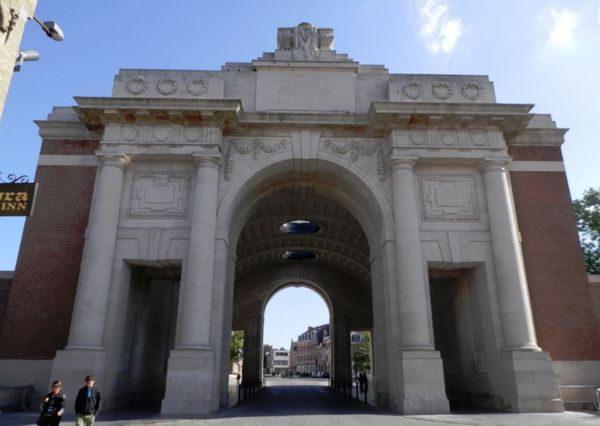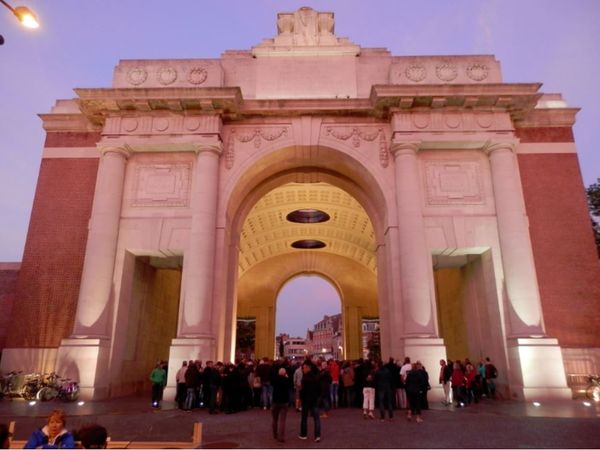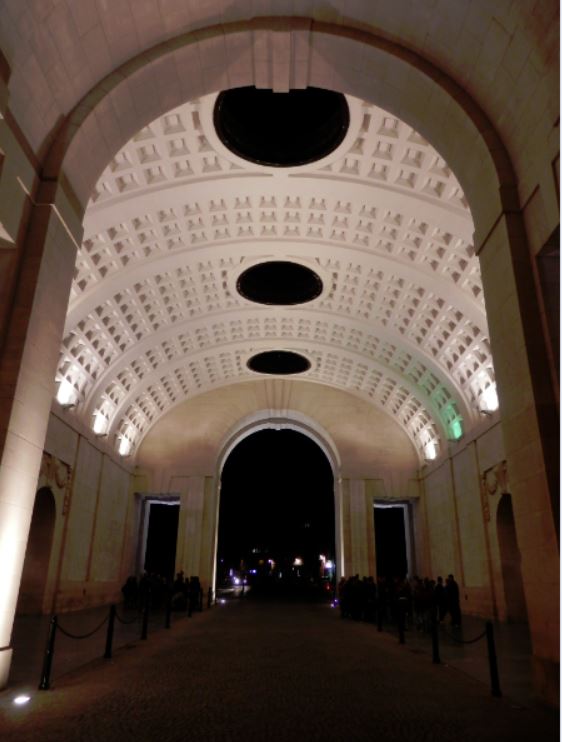Menin Gate Memorial
From Our Contribution
 Entering Ypres through the Menin Gate | |
 Menin Gate Service gathering | |
 Menin Gate Service | |
| Monument Details | |
|---|---|
Contents
History
In medieval times, the original narrow gateway on the eastern side of the city of Ypres was called the Hangoartpoort, "poort" being the Dutch word for gate. In order to prosper and maintain its wealth, the city of Ypres had to be fortified, to keep out potential invaders. During the 17th and 18th centuries, while under the occupation of the Habsburgs and the French, the city was increasingly fortified. Major works were completed at the end of the 17th century by the French military engineer Sebastien Le Prestre, Seigneur de Vauban. At the outbreak of the First World War in August 1914, the eastern exit simply cut through the remains of the ramparts and crossed a moat. The gateway was by this time known as the Menenpoort, or Menin Gate in English, because the road leading through the gateway led to the small town of Menen.
Ypres occupied a strategic position during the First World War because it stood in the path of Germany's planned sweep across the rest of Belgium, as had been called for in the Schlieffen Plan. By October 1914, the much battered Belgian Army broke the dykes on the Yser River to the north of the City to keep the western tip of Belgium out of German hands. Ypres, being the centre of a road network, anchored one end of this defensive feature and was also essential for the Germans if they wanted to take the Channel Ports through which British support was flooding into France. For the Allies, Ypres was also important because it eventually became the last major Belgian town that was not under German control
The importance of the town is reflected in the five major battles that occurred around it during the war. During the First Battle of Ypres the Allies halted the German Army's advance to the east of the city. The German army eventually surrounded the city on three sides, bombarding it throughout much of the war. The Second Battle of Ypres marked a second German attempt to take the city in April 1915. The third battle is more commonly referred to as Passchendaele, but this 1917 battle was a complex five-month engagement. The fourth and fifth battles occurred during 1918.
British and Commonwealth soldiers often passed through the Menenpoort on their way to the front lines with some 300,000 of them being killed in the Ypres Salient. 90,000 of these soldiers have no known graves.
Setting
Reginald Blomfield's triumphal arch, designed in 1921, is the entry to the barrel-vaulted passage for traffic through the mausoleum that honours the Missing, who have no known graves. The patient lion on the top is the lion of Britain but also the lion of Flanders. It was chosen to be a memorial as it was the closest gate of the town to the fighting, and so Allied Troops would have marched past it on their way to fight. Actually, most troops passed out of the other gates of Ypres, as the Menin Gate was too dangerous due to shellfire.
Its large Hall of Memory contains names on stone panels of 54,395 Commonwealth soldiers who died in the Salient but whose bodies have never been identified or found. On completion of the memorial, it was discovered to be too small to contain all the names as originally planned. An arbitrary cut-off point of 15 August 1917 was chosen and the names of 34,984 UK missing after this date were inscribed on the Tyne Cot Memorial to the Missing instead. The Menin Gate Memorial does not list the names of the missing of New Zealand and Newfoundland soldiers, who are instead honoured on separate memorials.
To this day, the remains of missing soldiers are still found in the countryside around the town of Ypres. Typically, such finds are made during building work or road-mending activities. Any human remains discovered receive a proper burial in one of the war cemeteries in the region. If the remains can be identified, the relevant name is removed from the Menin Gate.
Description
The inscription inside the archway is similar to the one at Tyne Cot, with the addition of a prefatory Latin phrase: "Ad Majorem Dei Gloriam – Here are recorded names of officers and men who fell in Ypres Salient, but to whom the fortune of war denied the known and honoured burial given to their comrades in death".[1]
On the town side of the gate is inscribed"TO THE ARMIES
OF THE BRITISH EMPIRE
WHO STOOD HERE
FROM 1914 TO 1918
AND TO THOSE OF THEIR DEAD
WHO HAVE NO KNOWN GRAVE."
Monument Details
Names are listed by Unit, by rank and then alphabetically.
11th Battalion
16th Battalion
28th Battalion
44th Battalion
51st Battalion
- ↑ https://en.wikipedia.org/wiki/Menin_Gate accessed 19 Nov 2017